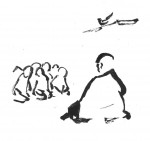Do you want to learn lean? Or do you want to talk about lean?
Before you read this post, ask yourself the following three questions:
- Am I improving customer value today? Am I investigating customer complaints systematically? I am challenging what I understand of my customer’s business model? What topic am I currently engaged in to improve the value I deliver to my customers?
- Am I improving my operational process today? Am I looking into operational hiccups? Am I discussing this with the teams who do the work? Am I working on getting them to cooperate better today? Am I working on making one task easier for employees – with them – today?
- Have I set up a visual environment where theses two topics are discussed daily? Did we take time to think today, or is it all about getting actions done? Have we listened to a customer’s specific issues or is it all about fixing the process? Did we learn from someone something only they knew today or are we discussing what everyone already knows?
If these three questions made you laugh and you feel that rather than reading the rest of this post, you’d better get back to them, you’re probably learning lean. If you still want to discuss lean after asking yourself these three questions, chances are you just want to learn about lean.

There’s an old story about a zen master about to do a lecture on zen to an assembled hall. As he was about to speak, and the audience quietened down to hear his teachings, a nightingale began to sing in the silence. “End of lecture” the zen master said after listening to the bird intently.
Lean is about learning by doing. It’s not so hard to get started – start with a customer wall:
- What is the complaint? What’s biting them hard enough that they bother to tell us?
- Why do they complaint? How is this a problem to them? How does our process produce this problem?
- How can we react? How can we make it up to the customer? Should we change how we work? Is there something we should learn to do better?
- Did it work? Does the customer feel better about us now (or even more enraged)? What did we expect? What went in a different way? What is the misconception in our way of thinking?
Then, from them on, you can add progressively all the techniques of lean to better understand your problems and work with your team to explore new ideas.
Lean discussions often debate how to 1) define the work, 2) organize the teams and 3) keep them going until the work is done. This is very useful in its own right. Lean, however, has a different focus: 1) how do I improve the current product according to customer usage? 2) how do I fix operational problems through better cross-department collaboration (and reduce lead-time), 3) how can I get teams to make their own work easier? 4) how do I develop each individual’s person’s skills.
These are deep discussions, but they don’t mean much unless you practice first.









